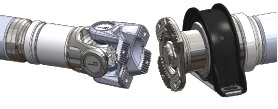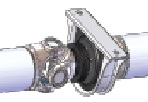Propshaft changes over the years.
Over the last 30 years commercial vehicle propshafts have changed quite dramatically.
Most commercial vehicle marques use a flanged propshaft. There are manufacturers such as Scania who use an open ended propshaft where the universal joint fastens direct to the vehicle input or output but for the purpose of this blog i will be talking about the flanged type.
(Scania do have a model with a flanged propshaft)
Over the last 30 years technology has moved forward at a fast pace in the manufacture of commercial vehicles. This as most owner drivers and fleet operators tell us is both a good and bad thing. Anyway, due to this advancement in things such as semi and automatic gearboxes, higher torque engines and physically bigger vehicles means that the propshafts have also had to change. The two biggest changes we have seen are the flange design and the introduction of the MIS assembly (slip mid).
Flange Design
30 years ago it was common to see flanges in varying sizes from 3” to 8” diameter with various bolt hole configurations between 4 and 12 holes.
These flanges had a male or female location to keep the propshaft centralized and high tensile bolts to take up the torque. These designs where known as SAE and DIN.
These types of flanges have largely been replaced by the KV (cross tooth) design which is a 4 bolt design with serrated teeth. These serrated teeth both centralize the propshaft and take up the torque. Due to the serrated teeth taking up the torque there is only 4 bolts in the flange. Very little torque is place on the bolts in this design but high tensile bolts are still used. This new design allows considerably higher torques to be transmitted through the propshaft.
Mis Assembly (Slip Mid)
This configuration isn’t a brand new thing to the propshaft world but they are starting to become more prevalent through large commercial vehicles.
Originally if vehicles have more than one propshaft it would consist of one sliding propshaft and one or more centre bearing propshafts (Mid Shafts).
These are connected to each other by bolting the centre bearing assembly to the sliding assembly.
The new MIS Assembly does away with several of the components that go in to the centre bearing assembly and sliding assembly and combines the two into one assembly. The bearing sits on the female part of the sliding section and instead of bolting the shafts together the shaft slide inside each other.

This in effect means that two expensive assemblies (centre bearing and sliding assemblies) are amalgamated in to one assembly. This would be great if it was reflected in the price of new propshafts but looking at main agent’s retail prices it seems to have made very little difference but luckily it has made a difference to aftermarket repairers and manufacturers such as us.
We can offer new propshafts and repairs at a significantly lower cost than the main agents using genuine manufacturer’s parts.
Call us on 01257 791681 with any of your propshaft questions.